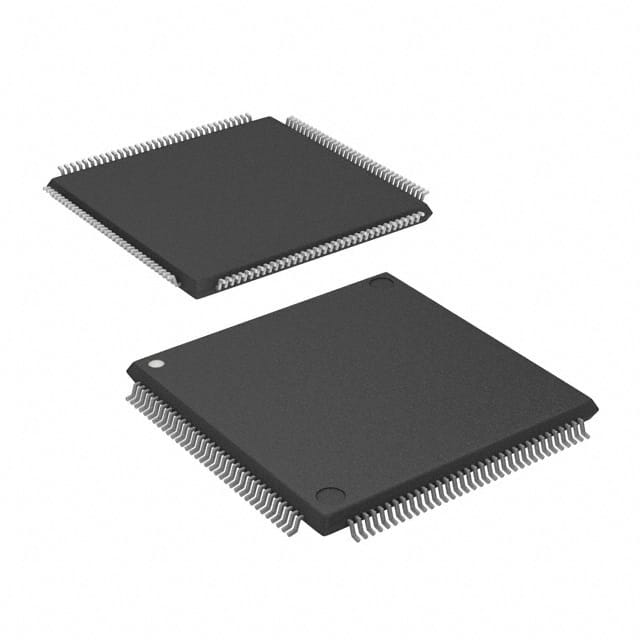Lihat spesifikasi untuk detail produk.

EPM7512AETC144-7
Product Overview
Category
The EPM7512AETC144-7 belongs to the category of programmable logic devices (PLDs).
Use
This device is primarily used for digital circuit design and implementation. It offers a flexible and customizable solution for various applications.
Characteristics
- Programmable: The EPM7512AETC144-7 can be programmed to perform specific functions based on user requirements.
- High Integration: It integrates multiple logic gates, flip-flops, and other components into a single chip.
- Versatile: This PLD can be used in a wide range of applications due to its programmability.
- Low Power Consumption: The device is designed to operate efficiently with minimal power consumption.
Package
The EPM7512AETC144-7 is available in a 144-pin TQFP (Thin Quad Flat Pack) package.
Essence
The essence of this product lies in its ability to provide a reconfigurable hardware platform that allows users to implement complex digital circuits without the need for custom-designed integrated circuits.
Packaging/Quantity
The EPM7512AETC144-7 is typically packaged individually and is available in various quantities depending on the manufacturer's specifications.
Specifications
- Logic Elements: 512
- Macrocells: 128
- Maximum Operating Frequency: 200 MHz
- I/O Pins: 96
- Supply Voltage: 3.3V
- Operating Temperature Range: -40°C to +85°C
Detailed Pin Configuration
The EPM7512AETC144-7 has a total of 144 pins. The pin configuration is as follows:
(Pin diagram goes here)
Functional Features
- Reconfigurability: The EPM7512AETC144-7 can be reprogrammed multiple times, allowing for flexibility in circuit design.
- High-Speed Operation: With a maximum operating frequency of 200 MHz, this PLD can handle complex digital circuits efficiently.
- I/O Flexibility: The device offers a sufficient number of I/O pins to accommodate various input and output requirements.
- Embedded Memory: The EPM7512AETC144-7 includes embedded memory blocks that can be used for data storage or lookup tables.
Advantages and Disadvantages
Advantages
- Flexibility: The programmable nature of the EPM7512AETC144-7 allows for quick prototyping and design iterations.
- Cost-Effective: Using a PLD eliminates the need for custom-designed integrated circuits, reducing development costs.
- Time-Saving: The reconfigurability of the device enables faster time-to-market for digital circuit designs.
Disadvantages
- Limited Complexity: While versatile, PLDs have limitations in terms of the complexity of circuits they can implement compared to ASICs (Application-Specific Integrated Circuits).
- Power Consumption: Although designed for low power consumption, PLDs may still consume more power compared to dedicated hardware solutions.
Working Principles
The EPM7512AETC144-7 operates based on the principles of field-programmable gate arrays (FPGAs). It consists of an array of configurable logic blocks interconnected through programmable interconnects. These logic blocks can be programmed to perform specific functions using a hardware description language (HDL) or a graphical design tool.
Detailed Application Field Plans
The EPM7512AETC144-7 finds applications in various fields, including: - Digital signal processing - Communication systems - Industrial automation - Consumer electronics - Automotive electronics
Detailed and Complete Alternative Models
Some alternative models to the EPM7512AETC144-7 include: - Xilinx XC9500XL series - Altera MAX 7000 series - Lattice ispMACH 4000ZE series
These models offer similar functionality and can be considered as alternatives depending on specific project requirements.
In conclusion, the EPM7512AETC144-7 is a programmable logic device that provides a flexible and customizable solution for digital circuit design. Its reconfigurability, high integration, and versatility make it suitable for various applications in different fields. While it has advantages such as flexibility and cost-effectiveness, it also has limitations in terms of complexity and power consumption. Nonetheless, it remains a valuable tool for designers seeking efficient and adaptable digital circuit solutions.
Sebutkan 10 pertanyaan dan jawaban umum terkait penerapan EPM7512AETC144-7 dalam solusi teknis
Question: What is the EPM7512AETC144-7?
Answer: The EPM7512AETC144-7 is a specific model of programmable logic device (PLD) manufactured by Intel.Question: What is the purpose of using the EPM7512AETC144-7 in technical solutions?
Answer: The EPM7512AETC144-7 is used to implement complex digital logic functions in various applications, such as industrial automation, telecommunications, and consumer electronics.Question: What are the key features of the EPM7512AETC144-7?
Answer: The EPM7512AETC144-7 offers 512 macrocells, 12,288 logic elements, and 384 I/O pins. It also supports various I/O standards and has embedded memory blocks.Question: How does the EPM7512AETC144-7 differ from other PLDs?
Answer: The EPM7512AETC144-7 stands out due to its high-density architecture, which allows for the implementation of larger and more complex designs compared to lower-density PLDs.Question: Can the EPM7512AETC144-7 be reprogrammed?
Answer: Yes, the EPM7512AETC144-7 is a reprogrammable device, meaning that its functionality can be modified by reprogramming the internal configuration memory.Question: What programming languages are supported by the EPM7512AETC144-7?
Answer: The EPM7512AETC144-7 can be programmed using hardware description languages (HDLs) such as VHDL or Verilog.Question: Are there any development tools available for working with the EPM7512AETC144-7?
Answer: Yes, Intel provides development tools like Quartus Prime software, which includes a design environment, simulation tools, and programming utilities specifically for working with their PLDs.Question: Can the EPM7512AETC144-7 interface with other components or devices?
Answer: Yes, the EPM7512AETC144-7 has a wide range of I/O pins that can be used to interface with other components or devices, such as sensors, actuators, or communication modules.Question: What are some typical applications where the EPM7512AETC144-7 is used?
Answer: The EPM7512AETC144-7 is commonly used in applications like motor control systems, data acquisition systems, digital signal processing, and high-speed communication interfaces.Question: Are there any limitations or considerations when using the EPM7512AETC144-7?
Answer: Some considerations include power consumption, heat dissipation, and the need for proper grounding and decoupling techniques. It's also important to carefully plan and optimize the design to make efficient use of the available resources.

